
The Next Trillion Dollar Wave - AI Narrative in Crypto: Who Are the Top Players?
Dec 12, 2024 21:40
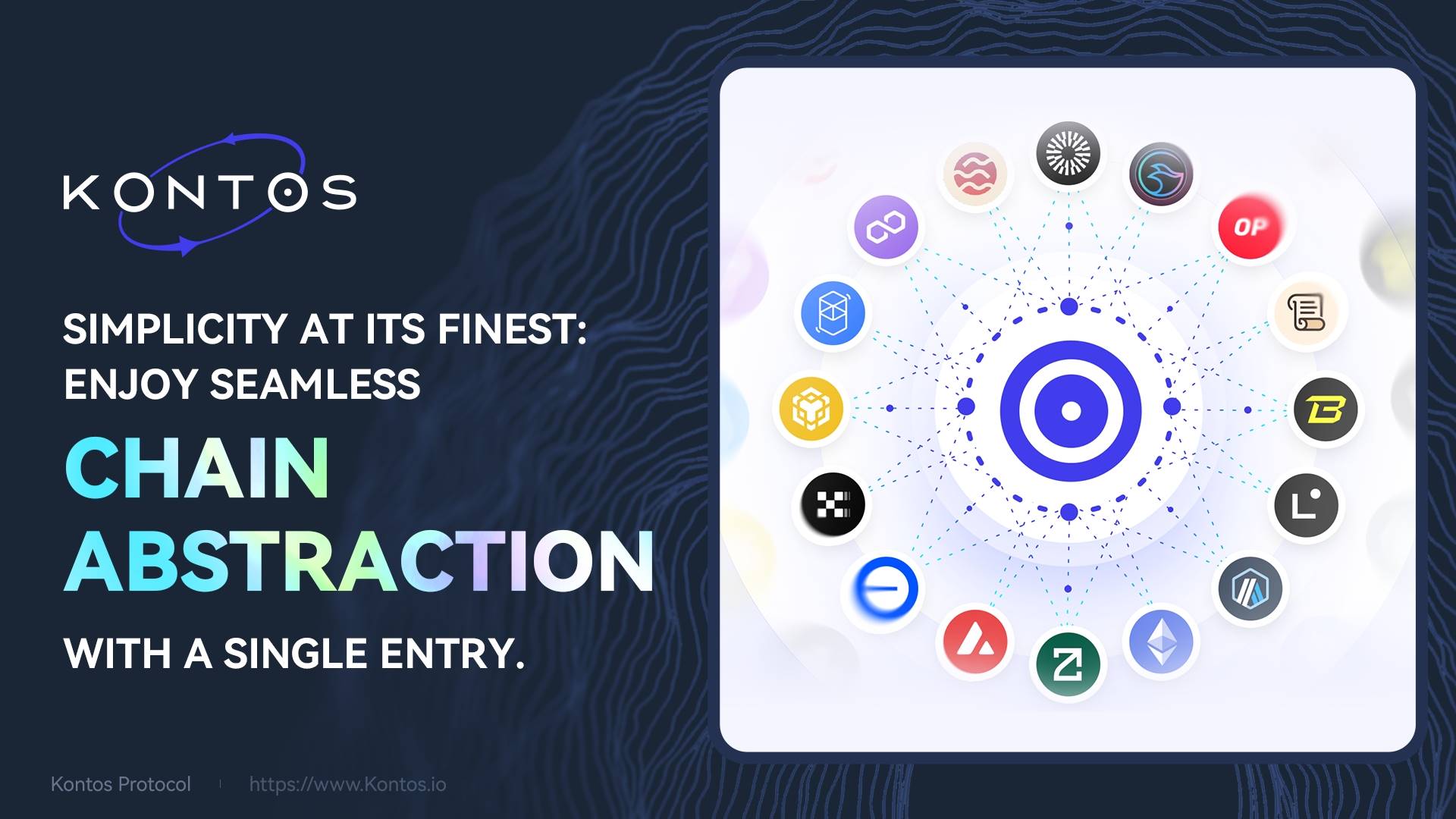
As history marches on, not everything moves forward.
Back in February 2014, Boston's train stations saw the installation of the first Bitcoin ATMs. Users didn't need to understand the mechanics—simply insert cash, input an address, and the BTC they purchased was sent directly to their wallet.
Back then, there was no Ethereum, no such thing as L1 or L2 layers. Everything was slower, but it was simpler.
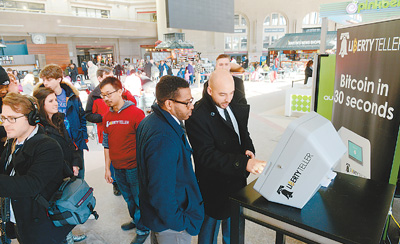
Fast forward to July 2024, and the landscape has grown significantly more complex. Imagine someone who boarded a high-speed train through a decade, arriving in today’s crypto world filled with anticipation. What would they encounter?
They might find themselves overwhelmed.
Hundreds of L1 and L2 platforms have emerged, each vying for attention and liquidity, while users must navigate through a maze of seed phrases, signatures, authorizations, cross-chain transactions, gas fees, and differences between EVM and non-EVM platforms.
For users, this isn’t progress; it’s a regression and a hassle.
A decade later, the need for transactions has only grown; yet our experience in the crypto world may feel even more primitive than in the early days of Bitcoin.
Amid calls for "simplifying everything," the concept of "chain abstraction" has never been more critical. Viewed by industry leaders as a knight in shining armor, it's seen as essential for addressing the fragmentation of experiences in the multi-chain era.
As this term becomes commonplace in elevated technical discussions, there's a growing desire for products that not only bring this concept to life but do so in a way that's immediately accessible and straightforward for users.
This led us to Kontos, a promising contender that simplifies chain abstraction:
It's the first user-centric infrastructure supported entirely by Zero-Knowledge Proofs (ZKP). With Kontos, users don't need to fret over private keys or seed phrases, nor worry about gas fees on the target chain, as it supports seamless transactions and transfers across all chains.
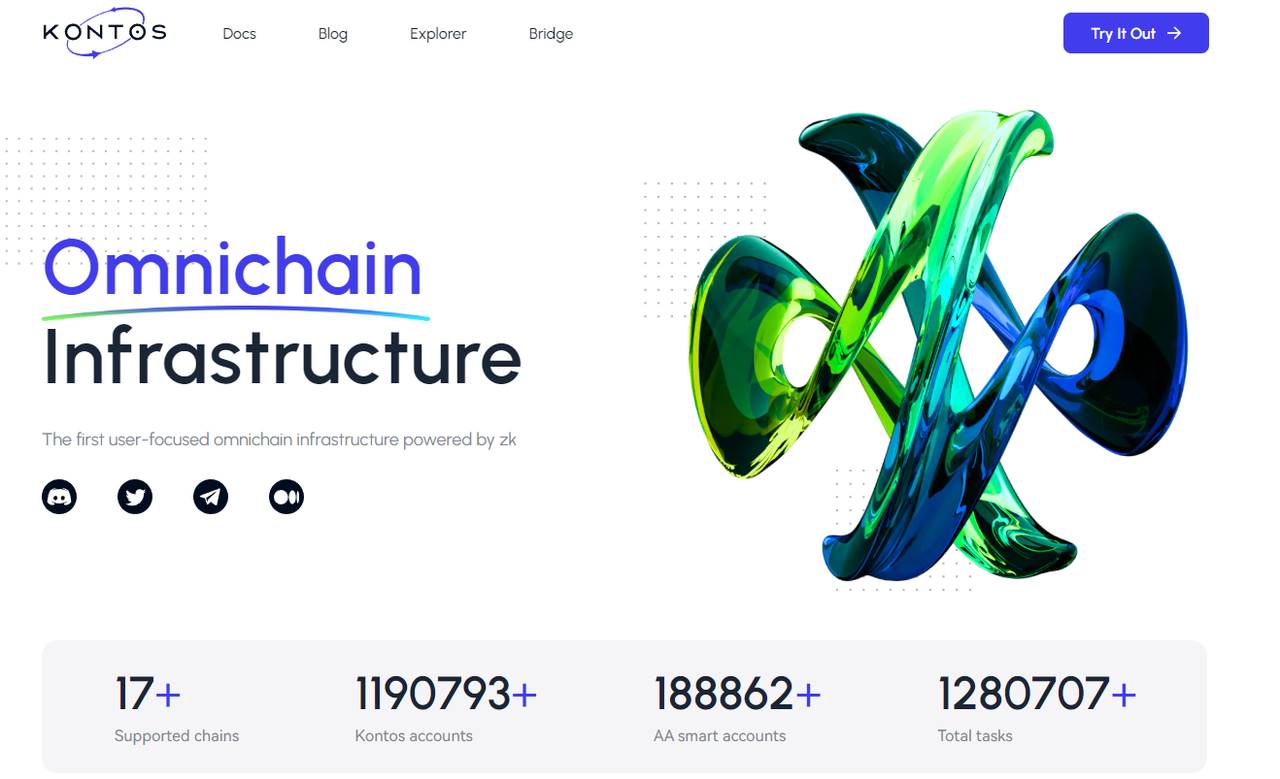
What’s even more significant is that when you use Kontos, you’re greeted with an interface that’s straightforward and easy to grasp. All the complex technology is abstracted away, reminiscent of the Bitcoin ATM at the train station—what you intend is exactly what you get, directly and simply.
A decade has come full circle, and it turns out that the simplest products often capture the most market interest.
If you’re intrigued by such products and the idea of chain abstraction, dive into this edition with us. We’ll explore the evolution of chain abstraction, seek solutions to fragmented experiences, and see how Kontos achieves elegance through simplicity.
Before diving into Kontos's specifics, it’s crucial to understand more about chain abstraction.
When did you first start hearing about chain abstraction?
A narrative gains traction not just through discussion but because it addresses genuine pain points. Near’s founder, Illia, keenly captured the core demands of users as early as January this year:
"End users don't care about the underlying blockchain. They just want the apps to work."
This simple yet profound demand seems almost unattainable in today’s complex Web3 landscape—with its myriad of chains, modules, and assets. It's within this abundance that we face the cumbersome issues caused by liquidity fragmentation and modular functionality.
You find yourself juggling different wallets and seed phrases, mastering various cross-chain bridges, making sure there’s enough gas for your transactions, and distinguishing between different L1s and L2s.
But should this really be your concern?
No other industry expects its users to be as proficient in various "skills" as Web3 does. In other fields, users are kings; they are simply served.
In Web3, however, users are forced to become experts amid the overt complexities of technology, the tediousness of operations, and frequent mishaps. They are constantly equipped with knowledge, vigilance, and self-reliance.
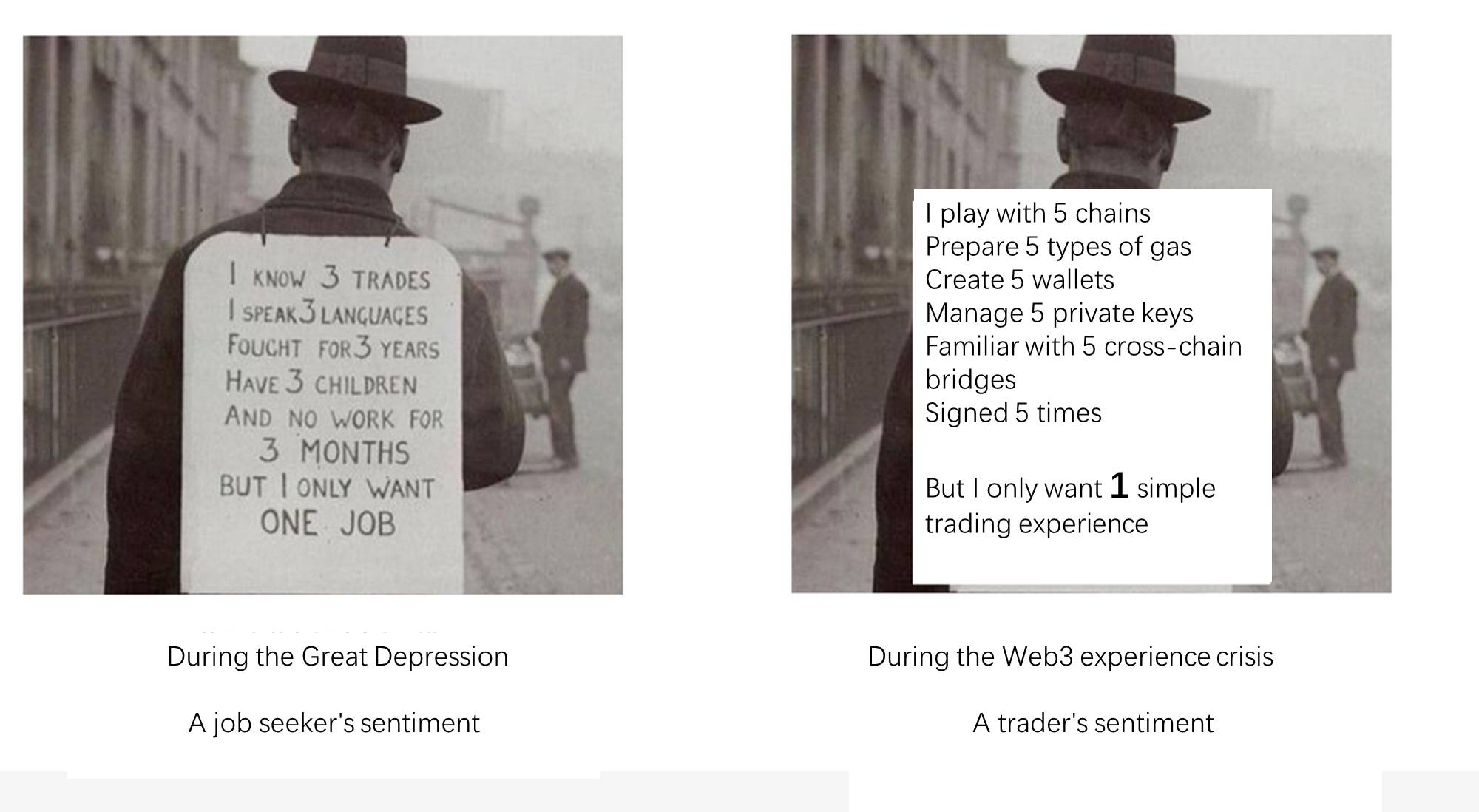
In 1929, the United States faced the infamous Great Depression, a time when even highly skilled job seekers struggled to find basic employment. Fast forward to 2024, and the world of Web3 is continuously grappling with an experience crisis, where users skilled in complex operations can’t seem to get a simple trading experience.
Echoes from history remind us that the demand for on-chain transactions is relentless, yet a simple trading experience remains elusive.
This complexity can be traced back through time to find its roots:
In 2015, Ethereum introduced a dual-account system (EOA and CA) which, while innovative, also planted the seeds for future challenges. EOAs couldn't execute complex contract logic on their own, making it impossible to accomplish multiple functions in a single interaction and leaving the critical responsibility of managing private keys to ordinary users.
This complexity in account management and transaction interactions gradually ushered the concept of "account abstraction" onto the historical stage.
By 2020, with the launch of Polkadot featuring designs for parachains and a relay chain, the foundation for inter-chain communication was laid, hinting at early solutions for the liquidity fragmentation of the impending multi-chain era and touching upon the challenges of cross-chain interoperability.
Thus, the complexities of cross-chain interoperability slowly brought the concept of "Omnichain" into focus.
By 2023, NEAR realized during its development that the increase in L1s and L2s was deteriorating user experience, prompting a need for the blockchain itself to be abstracted away from users. Other projects also recognized this problem and started to intensify their efforts in this direction.
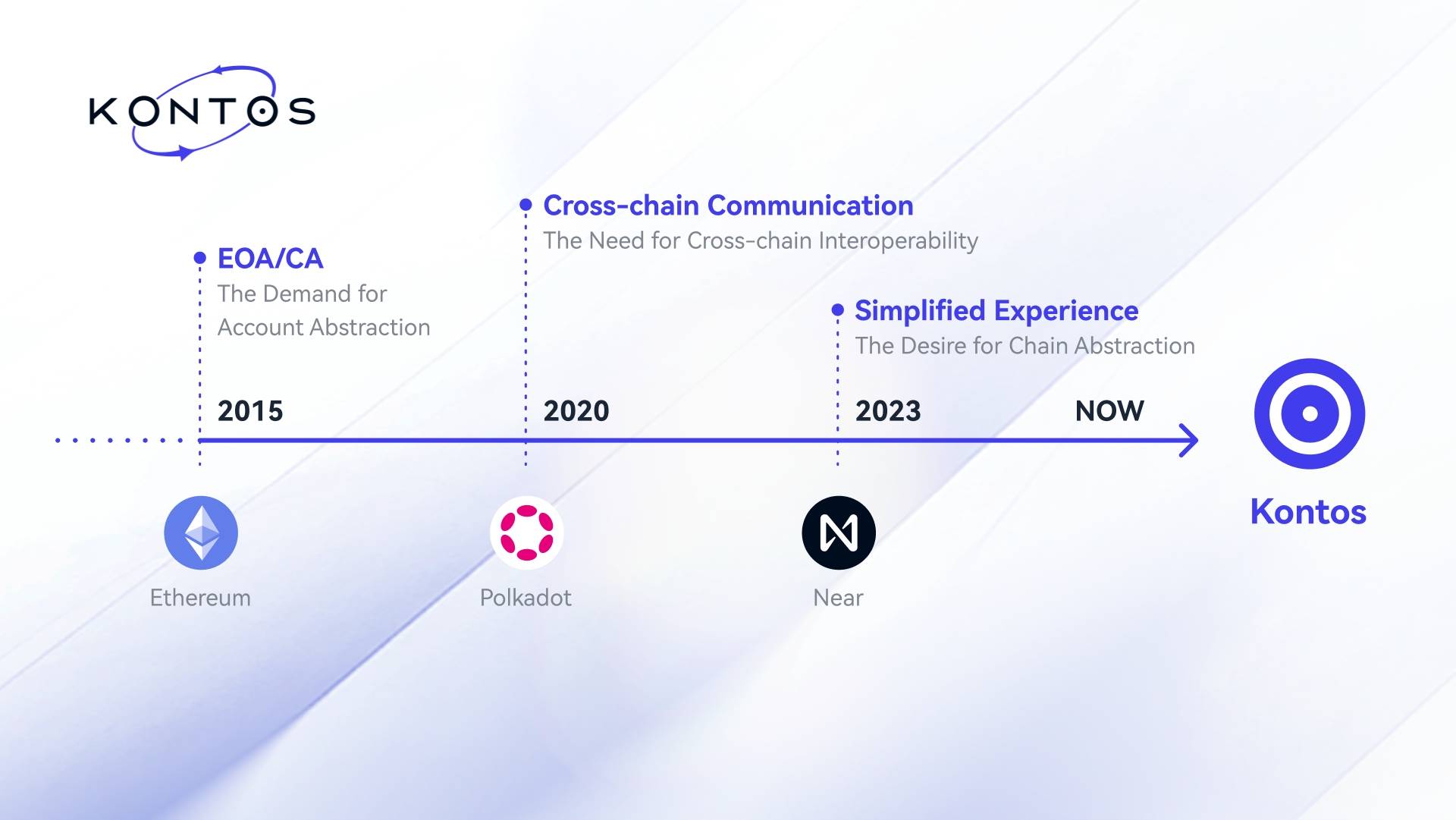
So, the accumulation of all these complexities has spotlighted "chain abstraction" in the ongoing quest to simplify the crypto experience.
Now, it's Kontos's turn.
While everyone is talking about chain abstraction, what will end users actually experience?
Whether it involves enabling a blockchain to support chain abstraction or providing an SDK that offers this capability, users generally aren’t concerned with the technical details.
What really makes users appreciate the benefits of chain abstraction is the interface they interact with.
In the case of Kontos, the first thing you'll notice is an interface that looks much like a wallet—it lists assets, facilitates transactions, and manages asset transfers, all prioritized according to your transactional needs. This straightforward portal allows users to seamlessly navigate the complexities of blockchain, making the power of chain abstraction palpably beneficial.
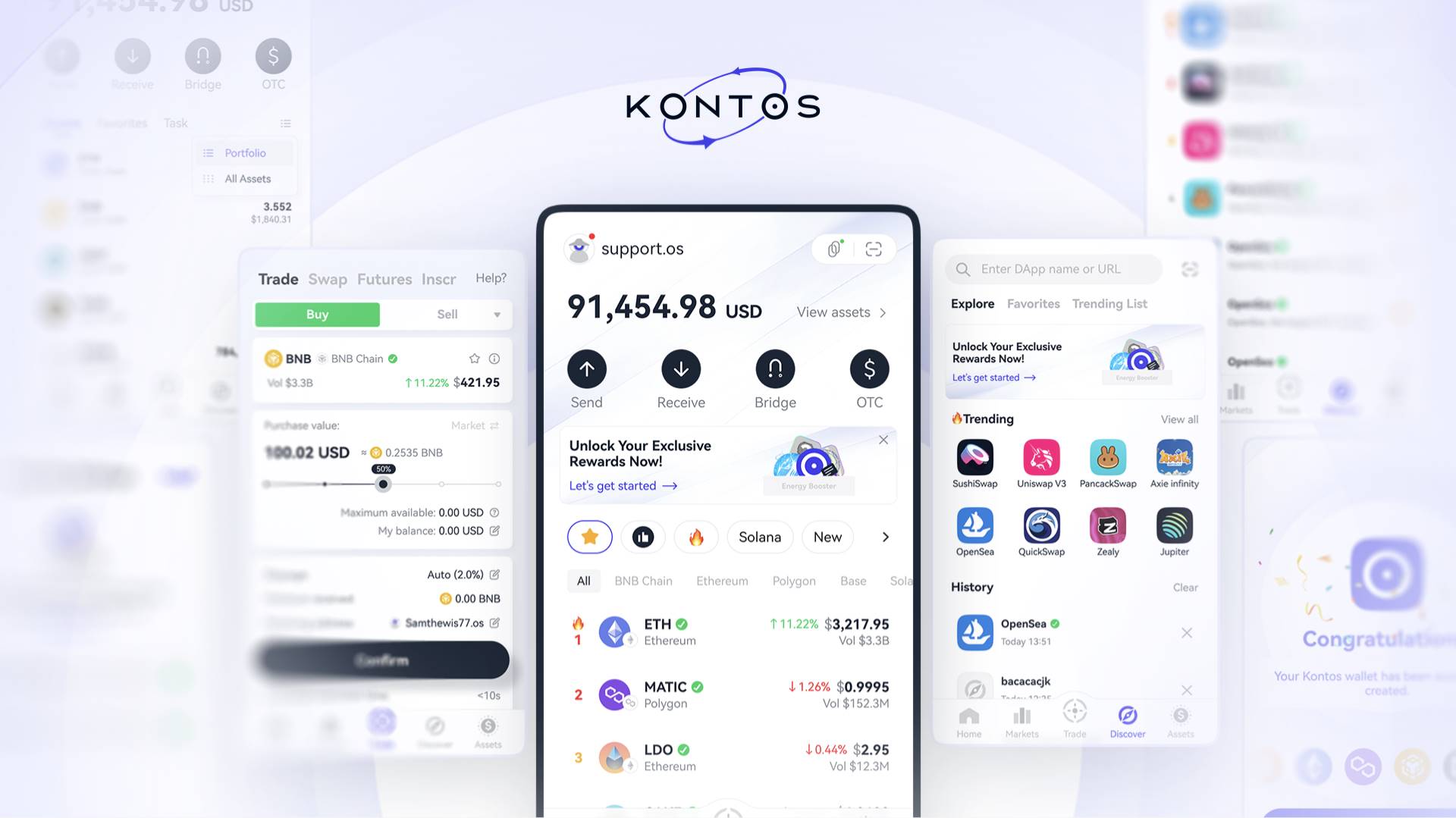
Yet, this gateway contains multitudes.
Kontos harnesses chain abstraction to deliver advantages subtly—by entirely abstracting the complexities of using native blockchain applications into a single, unified interface. This creates a universal, chain-agnostic access point for anyone interested.
This access point is the gateway you interact with; it wraps all complexities so thoroughly that it might just seem like an unusually straightforward wallet.
As you delve deeper into the experience, you'll begin to appreciate the profound simplicity.
First off, consider the account creation.
You can register a wallet just with a "username," completely free from the usual hassle of managing private keys and seed phrases. You'll quickly find that this username manages all your assets across all blockchains. There’s no need to switch between RPCs and networks like you would with MetaMask, nor do you need to understand these technical details at all.
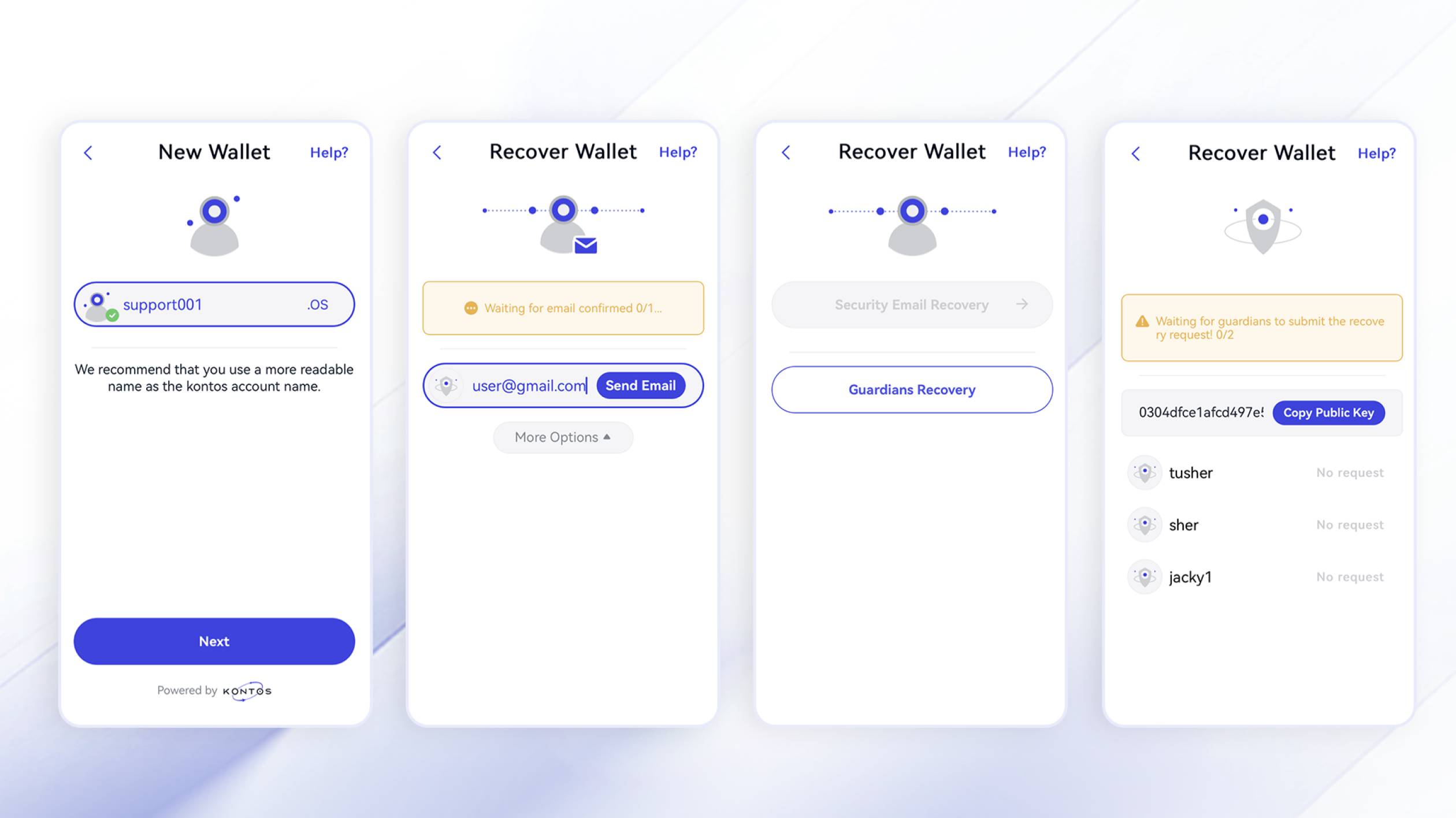
Around account management, when you need to restore your wallet, Kontos offers two intuitive recovery options: email recovery and guardian recovery. For email recovery, once you've set up a secure email, you can regain access to your account simply by sending an email to a specified address. Guardian recovery involves designating a trusted individual as your guardian; you send them your public key, and they confirm on Kontos to help restore your account—similar to the social recovery method often discussed by Vitalik Buterin.
The benefits of this system are clear: users don't have to wrestle with complex cryptography, the pairing of public and private keys, or intricate key management. The experience is more reminiscent of Web2 interactions.
Crypto accounts shouldn't deter new users or burden seasoned ones. Kontos simplifies this significantly, though much effort is made behind the scenes:
The .OS username essentially acts as a universal account, integrating social login, authentication, and wallet functionalities across different L1s and L2s. In the end, you experience managing everything through a single username, streamlining your interactions with the blockchain.
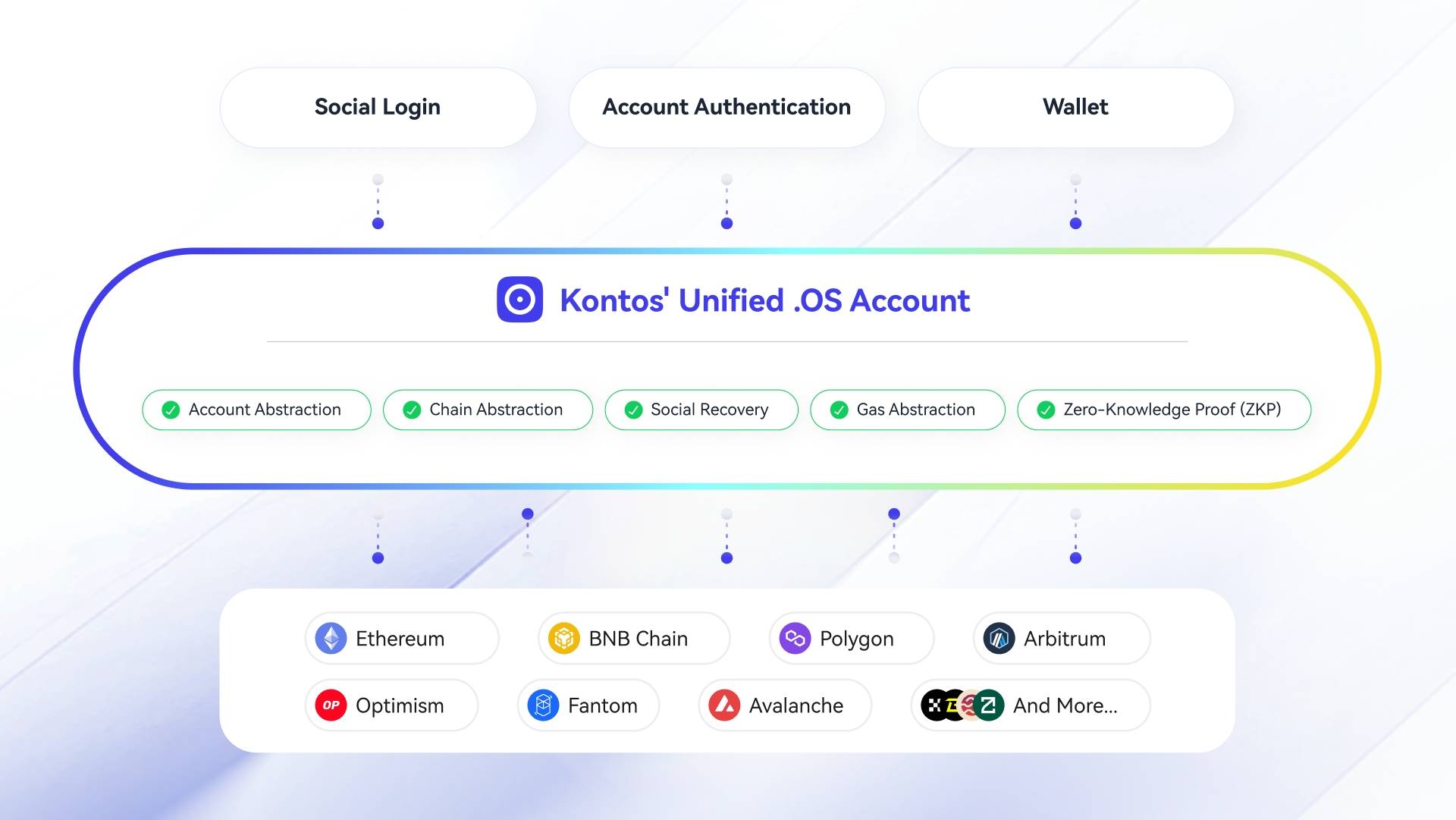
Next, let’s talk about how transactions are truly "chain-agnostic."
Kontos is currently integrated with 17 different blockchain networks, meaning users don’t need to worry about which chain they’re on or whether they have the necessary gas fees for that chain.
For instance, on Kontos, you could start a purchase by using USDT on Polygon to smoothly exchange for PEPE on Arbitrum. The system automatically handles the fee calculations and encapsulates the exchange process;
Not having Arbitrum gas isn’t a problem here, nor do you need to grapple with the complex logic of having to pre-store gas on different chains. All you need to know is that you pay a transaction fee, and your trade goes through.
You just exchange any token for another, and Kontos becomes a seamless portal. This simplifies the blockchain experience much like driving a car without needing to understand how the engine, gears, and other components work—as long as it drives well, that’s all that matters.
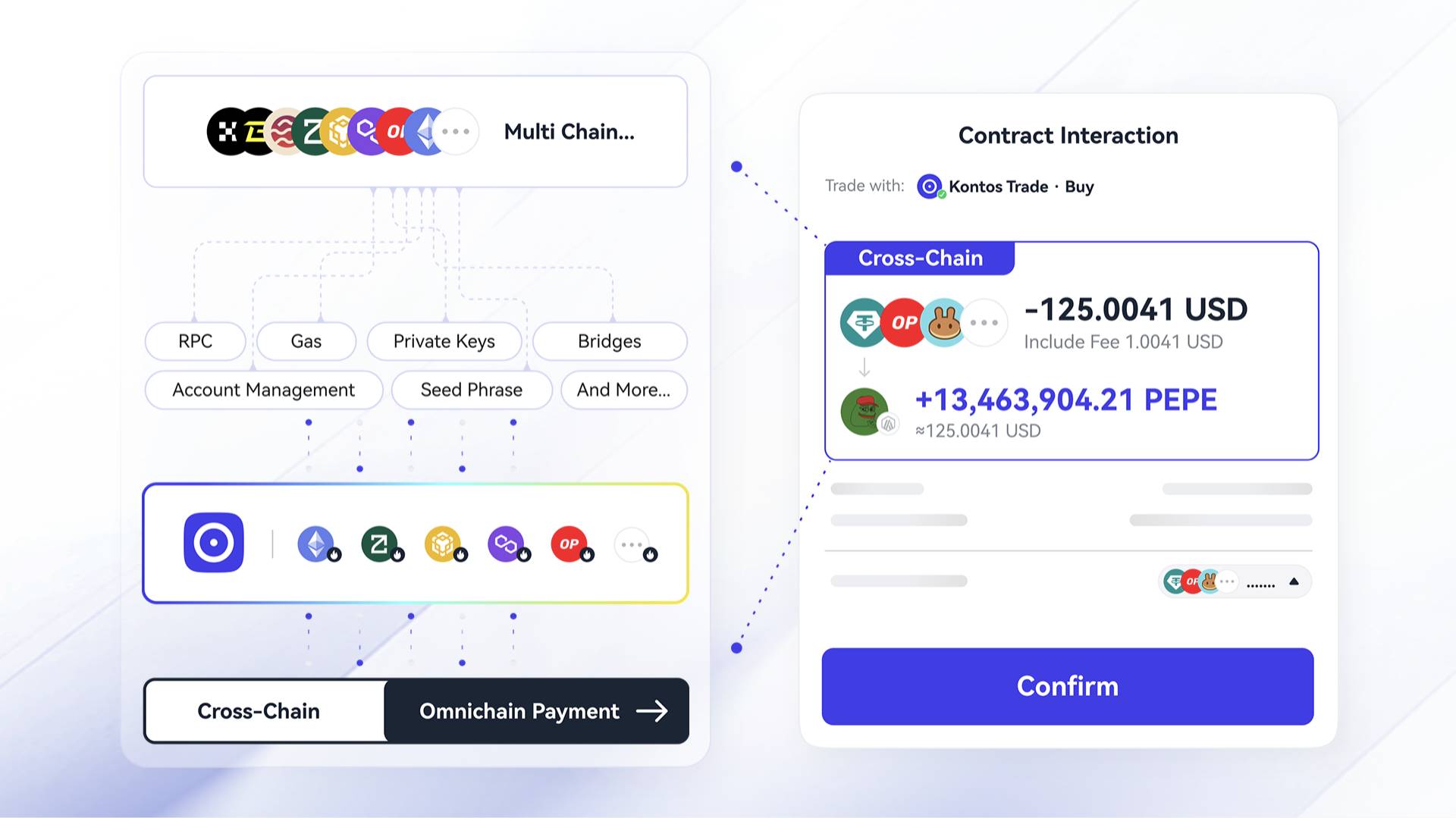
Players who navigate multiple blockchains know that you need to understand each chain's rules, grasp how cross-chain bridges process transactions, handle frequent signings, and figure out the most efficient routes for asset transfers.
Yet, with Kontos for asset transfers, there's no need to grapple with the underlying rules or worry about various signatures and interactions.
But how does Kontos achieve such smooth inter-chain asset exchanges and manage global gas fees?
Kontos essentially acts as a universal multi-chain hub. When users initiate a transaction, they only need to focus on two main factors: the target asset they want to purchase and their own payment capacity.
This efficiency is made possible because Kontos employs a Broker, who acts as the user's agent, handling all transaction details across different blockchains. When a user submits a request, the Broker assesses their payment ability and, based on real-time market conditions, uses the user's funds to acquire the desired asset. During this process, the Broker autonomously decides how to cover gas fees on the target chain.
For users, all this happens behind the scenes. They simply need to make sure they have enough assets to cover the total cost of their request; the Broker handles the nitty-gritty details of gas payments and exchanges.
This setup significantly streamlines user operations, offering a more intuitive and seamless experience. Users no longer need to manage different chains' gas tokens or decode complex exchange routes. Kontos wraps up these complexities in the Broker layer, enabling users to focus entirely on their needs.
However, it's crucial to note that while the Broker greatly simplifies transactions, users maintain absolute control over their assets. The Broker can only perform tasks specifically authorized by the user and cannot independently access the user’s funds. This ensures the safety and security of user assets.
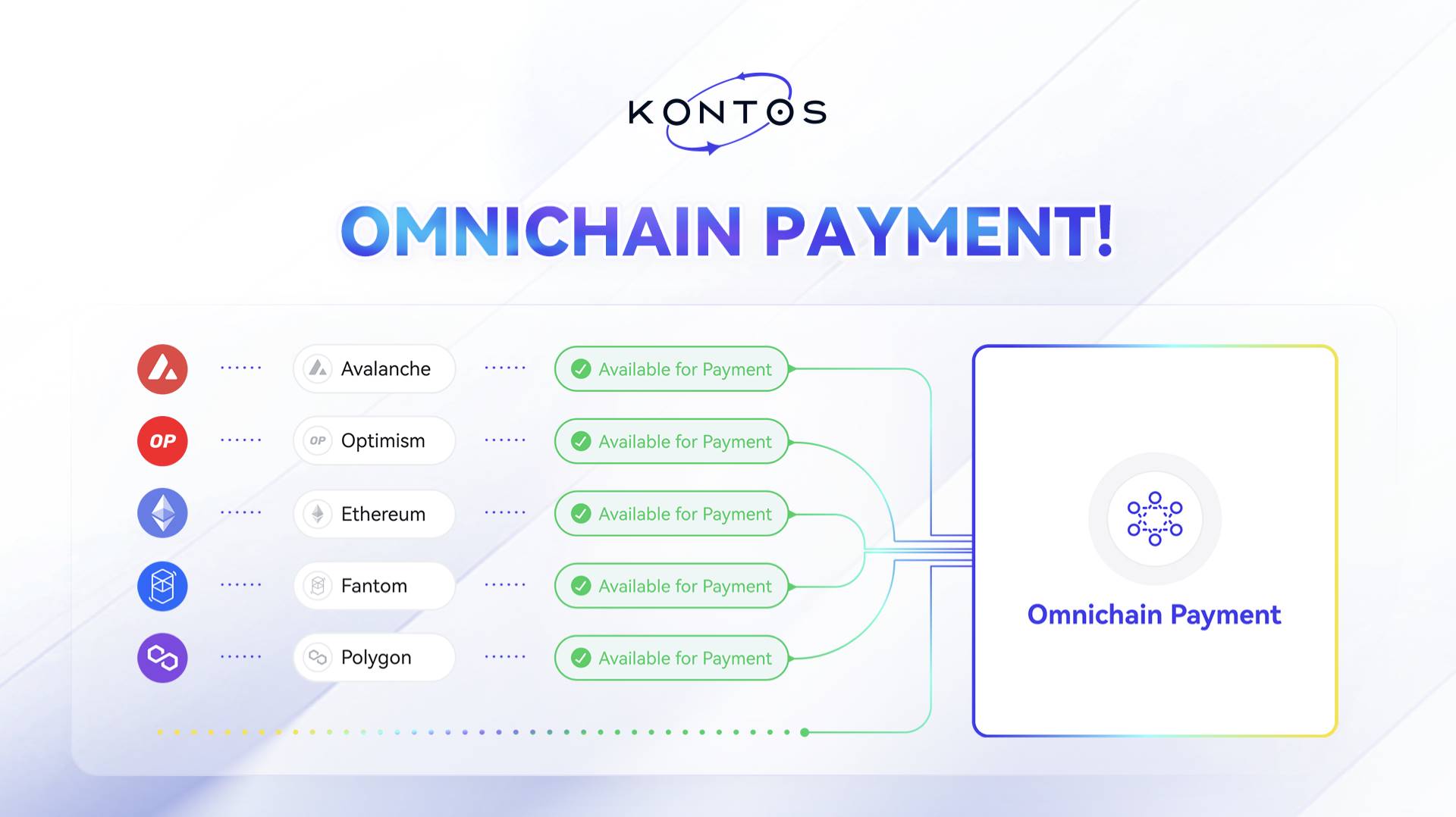
In the layers of account management, asset management, and transaction specifics, the real power of chain abstraction emerges:
It frees users from worrying about the process by abstracting complex operations into a "one-click" completion, turning intentions directly into results.
Overall, we find Kontos to be incredibly intuitive and easy to use. It's perfect as an introductory wallet for newcomers to the crypto world or as an alternative for seasoned users seeking to streamline their experience. The less users need to worry about, the more aligned the gateway is with user logic, thus enhancing its value.
Currently, Kontos is accessible via Discord, PC, and mobile wallets. Interested parties can click here to start exploring.
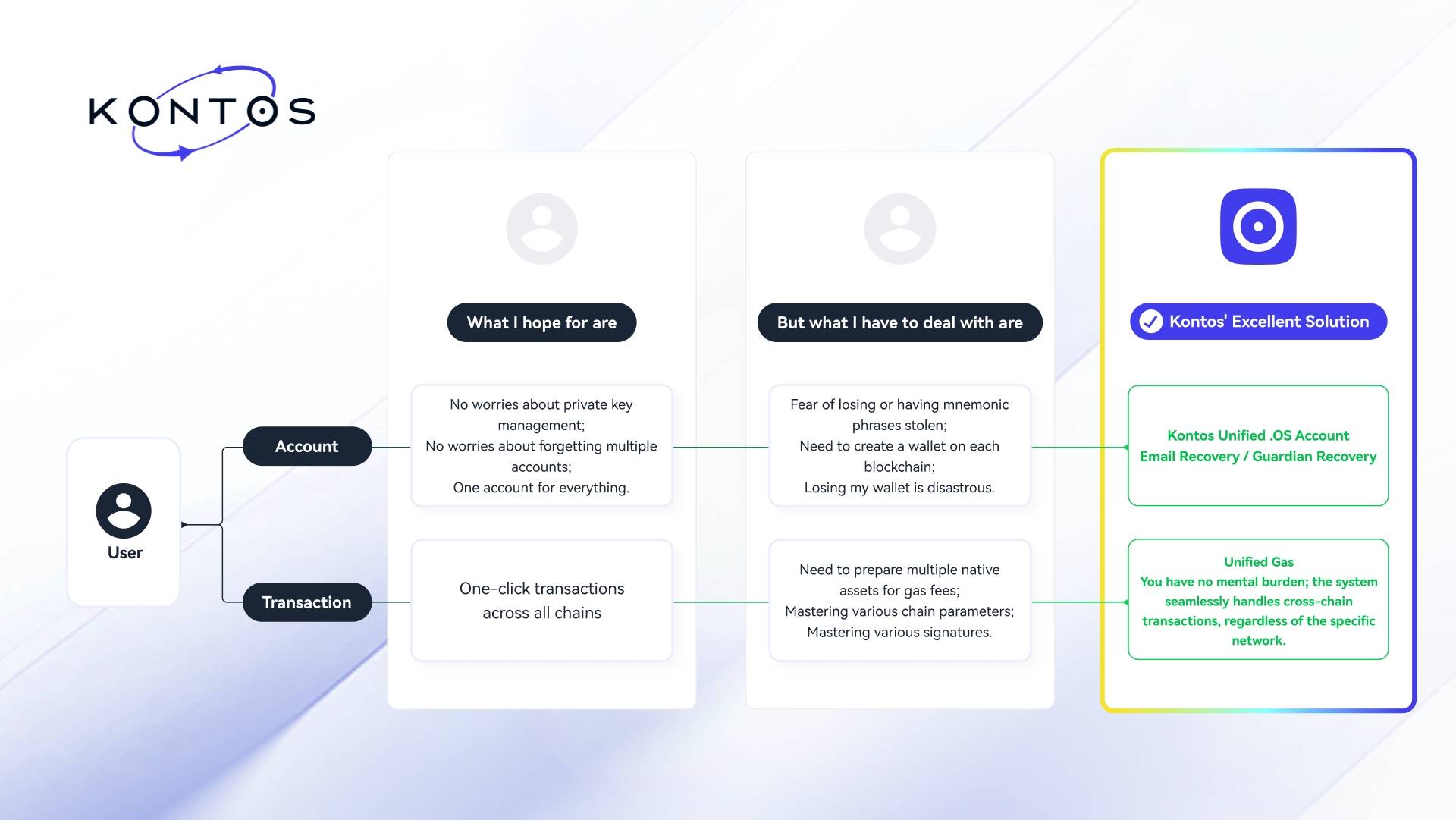
From the user's perspective, the interface that Kontos presents is remarkably straightforward.
This design philosophy—keeping it simple for the user while handling the complexity internally—demands extensive technical encapsulation. Thus, the concept of chain abstraction might seem succinct, but behind the scenes, it involves intricately packaging multiple components that shouldn't be overtly exposed to users.
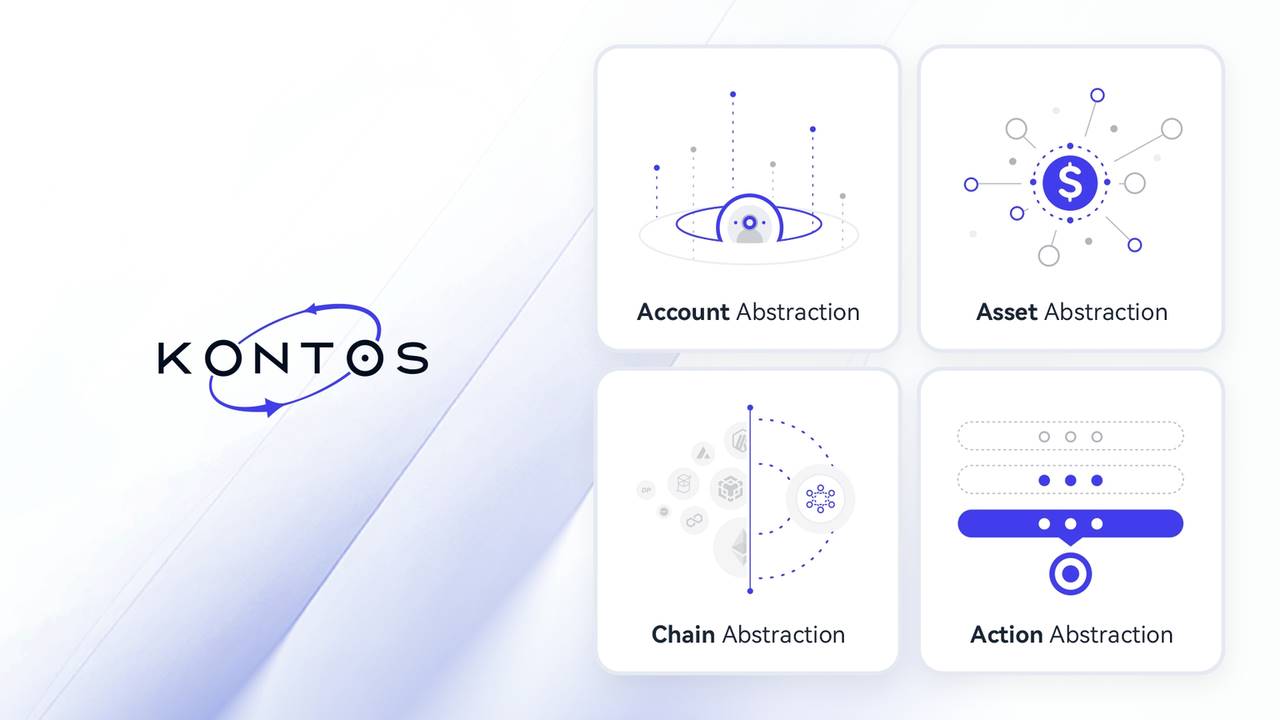
Going deeper into Kontos's core, you'll see that those frequently heard buzzwords have undergone thorough refinement and careful consideration in their practical application. For example, the concept of "chain abstraction" typically refers to ease of access and interaction with various blockchains.
But in implementing Kontos, there are several key mechanisms working behind the scenes: target chain state synchronization, ZK proofs, and the Broker network. Let's unpack this a bit:
Lightweight Client Verification: Kontos operates lightweight clients for each chain in its network. These clients fetch block headers and states from other chains and verify their correctness directly on Kontos. This setup enables Kontos to authenticate the state across any blockchain.
ZK Proofs: When other chains need to verify Kontos’s state, it utilizes a recursive zk-SNARK proof mechanism. This system allows other chains to verify only the final layer of zk-SNARK proof to confirm the state of many blocks on Kontos, significantly boosting the efficiency of cross-chain verifications.
Broker: When users perform cross-chain transactions on external chains, the Broker service pre-pays the fees and assets, smoothing out the user experience.
Similarly, the term "account abstraction" often describes how blockchain accounts' functions and permissions are abstracted, allowing them to perform more complex operations.
Kontos takes this further by designing a dual-layer account model: the upper layer uses user-friendly account names (like XXX.OS) for registration, easy recall, and management, while the lower layer links these account names to Account Abstraction (AA) accounts on various public chains.
This structure enables features such as social recovery alongside a no-private-key-needed approach.
Additionally, you might have overlooked "asset abstraction", where Kontos acts as a universal gas hub, allowing users to pay transaction fees using any asset from any blockchain.
Together with chain abstraction, this setup is akin to traveling without worrying about the local conditions or needing the local currency of your destination.
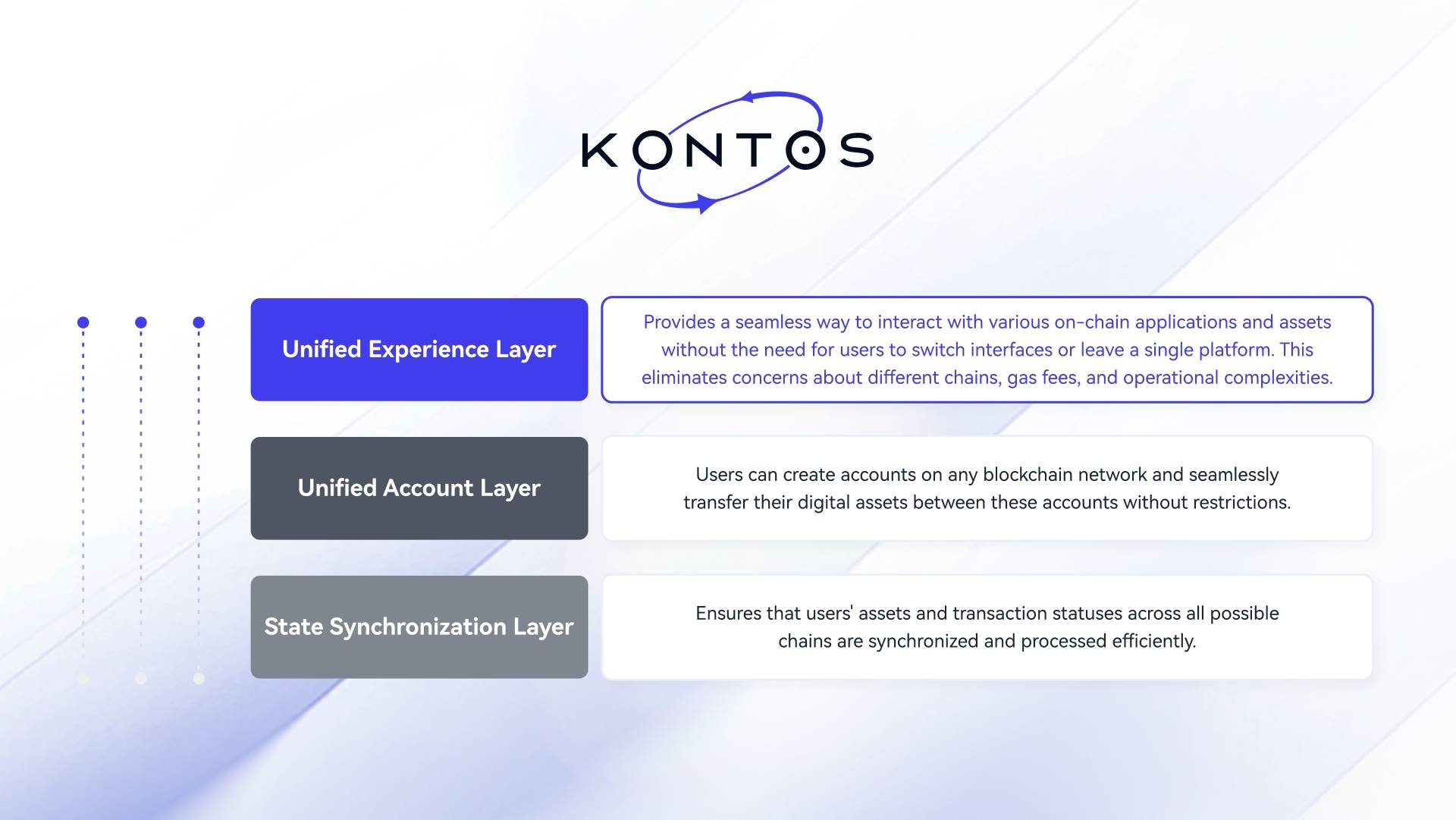
Ultimately, these various layers of abstraction come together to form what might be termed "behavioral abstraction"—users achieve their goals with a single click while various backend components quietly support the action.
Let’s delve into how a seemingly simple transaction, like "purchasing Degen tokens on Base using USDT from Polygon," is executed within Kontos:
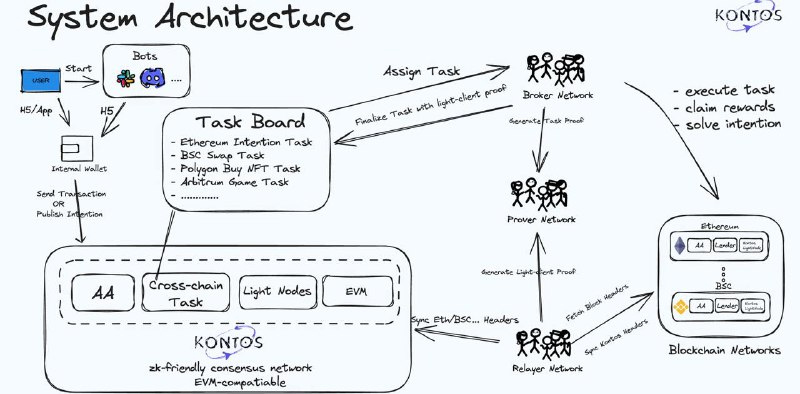
User Initiates Task: Via an H5 page or an app, the user starts a task to buy Degen tokens on Base using USDT from Polygon.
Task Publication: The user's intent is posted on a task board, which then assigns the task to the Broker network.
Broker Network Activation: Nodes within the Broker network pick up the task and carry out the cross-chain operation. After completing the operation, they generate a task proof.
Proof Verification: This task proof is forwarded to the Prover network, which verifies the proof and generates a light-client proof.
Relayer Network Synchronization: The Relayer network is responsible for syncing the block headers from both the Polygon and Base blockchains, updating them on the Kontos blockchain to ensure cross-chain data consistency and security.
Ultimately, while the complexity is managed internally, simplicity is delivered to the user, resulting in a nearly seamless experience.
The ideal infrastructure is one that users don't even notice, where they only experience smooth frontend interactions; and for traders and users, the ultimate dream is simplicity.
Moreover, a critical yet often overlooked element in this design is security.
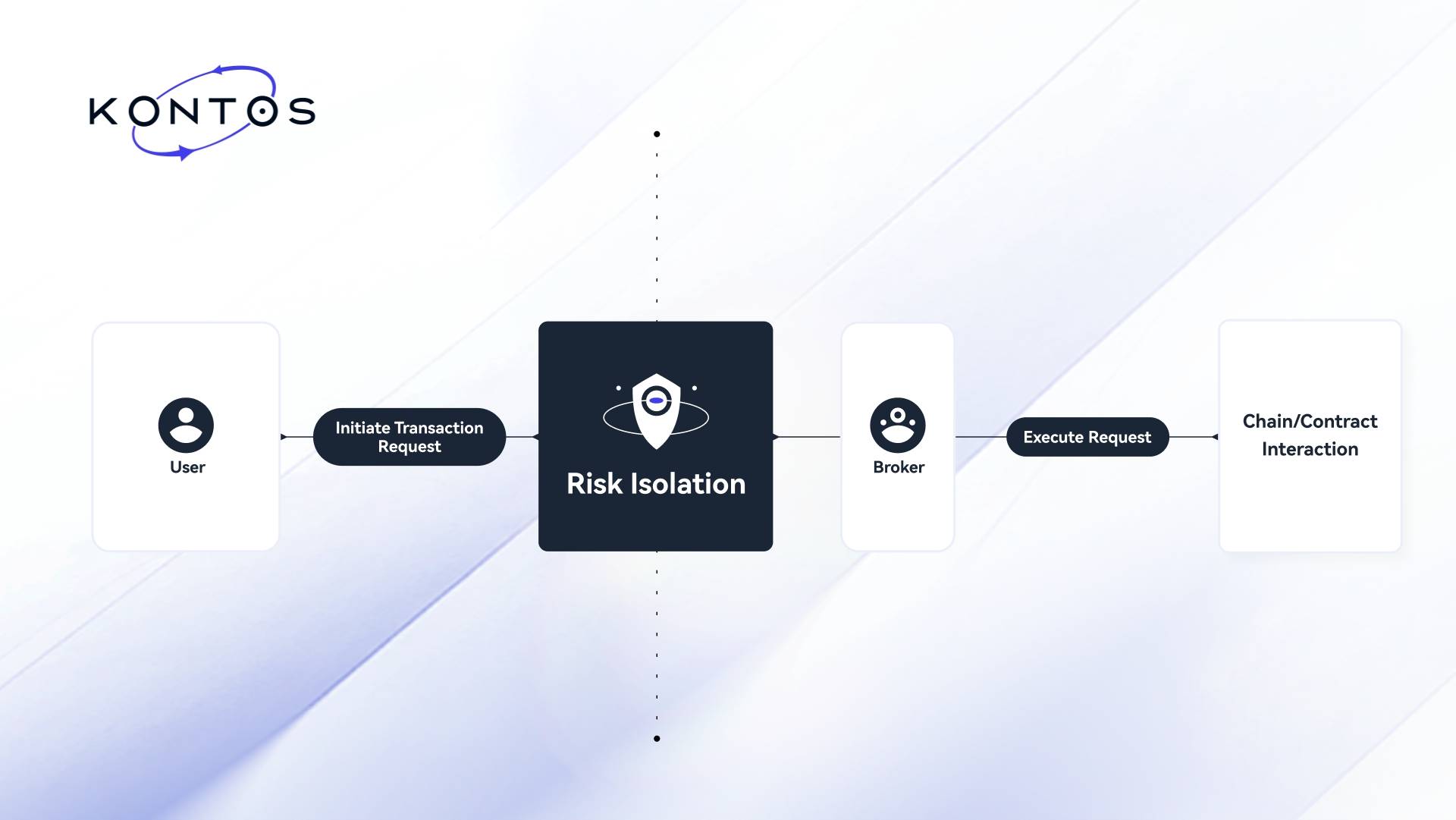
With the division of transaction signing and execution into separate roles, users and brokers, users no longer have to execute transactions themselves.
Instead, they simply click a button to sign the transaction, allowing experienced participants to handle all on-chain requirements and find the optimal execution path.
These experienced participants absorb the risks associated with interacting across various applications on L1 and L2 levels, managing the associated gas fees for different tokens across chains, reorganization risks (when dealing with two versions of a chain), and other execution risks.
They then price their services accordingly to cover these risks.
In this setup, users are spared the complexities and risks associated with using on-chain products and services, as these are managed by specialized market participants.
While researching Kontos and the development of chain abstraction, I've been reflecting on what the ideal form of a chain abstraction product might look like. Perhaps the best version has already been around, just not in its purest form.
Consider centralized exchanges (CEXs), which are essentially a form of chain abstraction.
You don't need to worry about which chain your assets are on or manage various keys; you can deposit and trade freely. Although CEX operations are not on-chain but rather reflect on-chain states in off-chain databases, they deliver the seamless experience that chain abstraction aims to provide.
From a more decentralized and crypto-native perspective, chain abstraction could evolve into an on-chain version of a CEX, prioritizing user experience and technical encapsulation.
The saying "The future is already here — it's just not very evenly distributed" aptly applies here.
Chain abstraction services will inevitably become a shortcut to mass adoption. Those with ready-to-use products will be able to capture users' attention sooner.
The small, emerging projects we see today might one day lead the way in enhancing the Web3 user experience.
Kontos, with its current product experience and technical architecture, already offers a streamlined and effortless interface, making it "worth trying." Whether it can become the "go-to choice" depends on further strategic developments and market trends.
Additionally, as Kontos grows and gathers more usage data, there may be opportunities to expand into services focused on data openness, retrieval, and analysis.
Demand will always create a market; but who will dominate the market for chain abstraction? We'll just have to wait and see.
Recommendation

Unpacking Pi Squared: Academic Leaders from Elite Universities Spearhead a $12 Million Funding for a ZK Universal Settlement Layer
Jul 07, 2024 14:26
BTCFi
Comparing Bitcoins Top 4 Scaling Solutions: Which Will Unleash BTCFis Trillion-Dollar Potential?
Nov 11, 2024 15:15
NAVI
NAVIs Rise in Sui Ecosystem: Building on Lending + LST Success, Ready to Scale as Native USDC Launch
Nov 11, 2024 15:34